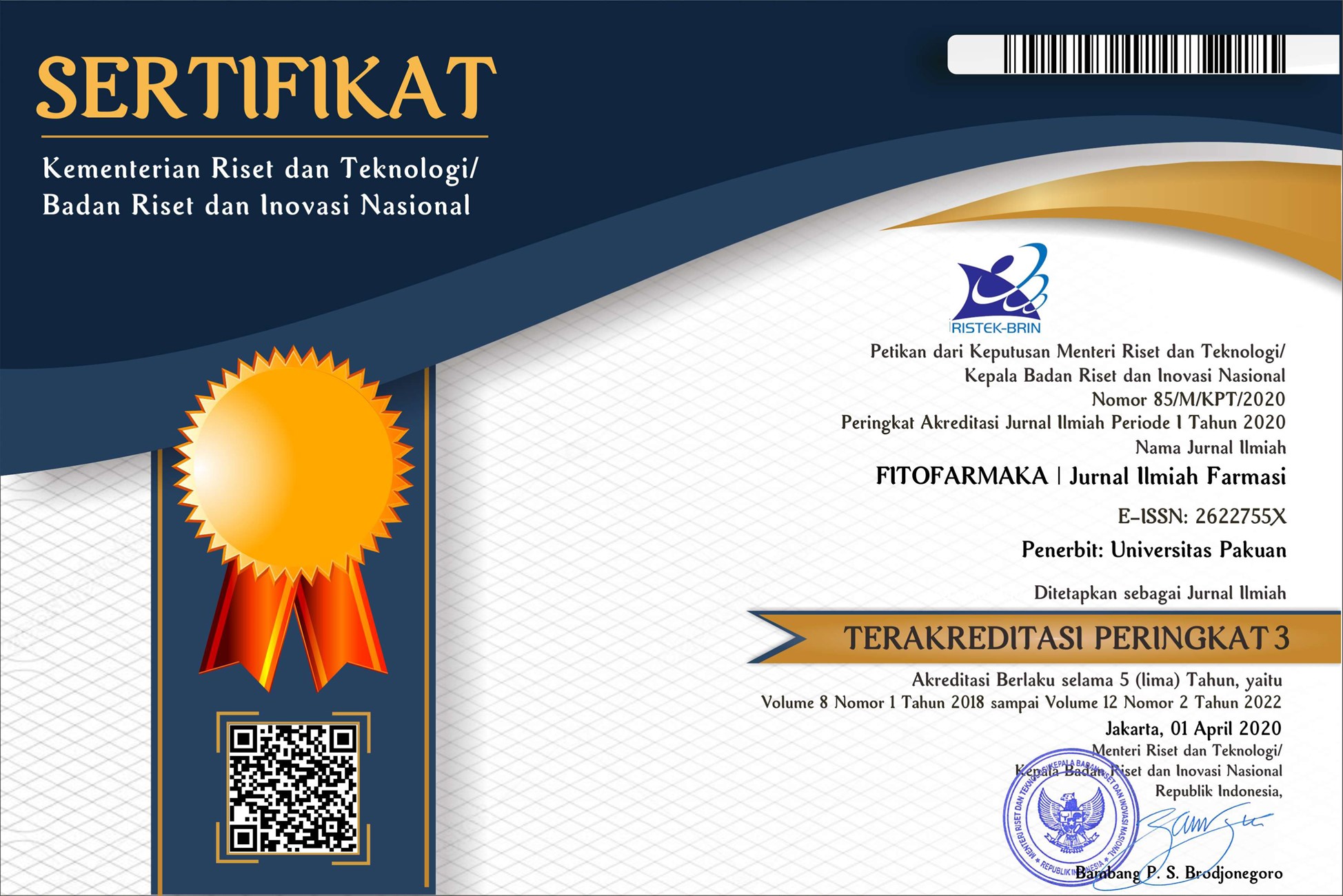Analysis of Urinary Fibronectin Levels in Patients with Type 2 Diabetes Mellitus and Non-Diabetes Mellitus
Abstract
Diabetic nephropathy is a microvascular complication associated with high glucose levels in individuals with diabetes mellitus (DM). Fibronectin, an early marker of diabetic nephropathy, can indicate the occurrence and progression of renal damage. This cross-sectional study aimed to compare urinary fibronectin levels in patients with type 2 diabetes mellitus and non-diabetes mellitus. A sample of 50 DM patients was divided into two groups: the DM group and the non-DM group. Urinary fibronectin levels were measured using the ELISA method, while albuminuria levels were determined by the albumin-to-creatinine ratio (ACR). Statistical analysis was performed to assess the relationship between urinary fibronectin levels and urine albumin. Results: The average urinary fibronectin level in DM patients was 2.07 ± 3.04 ng/mL, which was slightly higher than the level observed in non-DM patients (1.09 ± 0.56 ng/mL). However, this difference was not statistically significant (p > 0.05). Additionally, there was no significant relationship found between urinary fibronectin levels and urine albumin (p = 0.001). Conclusion: The findings of this study indicate that urinary fibronectin levels in individuals with DM were slightly higher than those without DM. However, this difference did not reach statistical significance. The lack of a significant relationship between urinary fibronectin levels and urine albumin suggests that fibronectin may provide additional information about renal damage in DM patients, independent of albuminuria. Further research is necessary to explore the clinical significance of urinary fibronectin as a potential biomarker for diabetic nephropathy.
Keywords
References
Abdelsalam, M., Wahab, A. M., El Sayed Zaki, M., & Motawea, M. (2020). MicroRNA-451 as an Early Predictor of Chronic Kidney Disease in Diabetic Nephropathy. International Journal of Nephrology, 2020. doi.org/10.1155/2020/8075376
Artasensi, A., Pedretti, A., Vistoli, G., & Fumagalli, L. (2020). Type 2 diabetes mellitus: A review of multi-target drugs. Molecules 25(8): 1987.
doi.org/10.3390/molecules25081987
Ballana, E., Pauls, E., Clotet, B., Perron-Sierra, F., Tucker, G. C., & Esté, J. A. (2011). β5 Integrin Is the Major Contributor to the αv Integrin-Mediated Blockade of HIV-1 Replication. The Journal of Immunology, 186(1): 464-470.
doi.org/10.4049/jimmunol.1002693
Bandiara, R., & Soelaeman, M. R. (2011). Podosit dan penyakit ginjal diabetes. Maranatha Journal of Medicine and Health, 11(1): 80-91.
Belly, C., Bonula, S.P., Kandukuri, U.R., Kuchulakanti, H. (2020). A Review on Methods of Treatment for Diabetic Foot Ulcer. In: Satapathy, S.C., Raju, K.S., Shyamala, K., Krishna, D.R., Favorskaya, M.N. (eds) Advances in Decision Sciences, Image Processing, Security and Computer Vision. Learning and Analytics in Intelligent Systems, vol 3 (pp 66-73). Springer, Cham. doi.org/10.1007/978-3-030-24322-7_9
Bonger, Z., Shiferaw, S., & Tariku, E. Z. (2018). Adherence to diabetic self-care practices and its associated factors among patients with type 2 diabetes in addis Ababa, Ethiopia. Patient Preference and Adherence, 12: 963-970.
doi.org/10.2147/PPA.S156043
Brunton, S. (2016). Pathophysiology of Type 2 Diabetes: The Evolution of Our Understanding. The Journal of family practice, 65(4).
Buse, J. B., Wexler, D. J., Tsapas, A., Rossing, P., Mingrone, G., Mathieu, C., D’Alessio, D. A., & Davies, M. J. (2020). 2019 update to: Management of hyperglycaemia in type 2 diabetes, 2018. A consensus report by the American Diabetes Association (ADA) and the European Association for the Study of Diabetes (EASD). Diabetologia, 63(2): 221-228. doi.org/10.1007/s00125-019-05039-w
Chen, J., Hu, P., Wang, Y., & Zhu, Z. (2022). Association between type 2 diabetes status and prevalence of liver steatosis and fibrosis among adults aged ≥ 40 years. BMC Endocrine Disorders, 22(1): 128. doi.org/10.1186/s12902-022-01046-y
Davies, M. J., Aroda, V. R., Collins, B. S., Gabbay, R. A., Green, J., Maruthur, N. M., Rosas, S. E., Del Prato, S., Mathieu, C., Mingrone, G., Rossing, P., Tankova, T., Tsapas, A., & Buse, J. B. (2022). Management of Hyperglycemia in Type 2 Diabetes, 2022. A Consensus Report by the American Diabetes Association (ADA) and the European Association for the Study of Diabetes (EASD). Diabetes Care, 45(11): 2753-2786. https://doi.org/10.2337/dci22-0034
Dhyani, A., Pulakazhi Venu, V. K., Uboldi, P., Muro, A. F., Catapano, A. L., & Norata, D. G. (2016). Absence of fibronectin-EDA contributes to sepsis outcomes in a murine model. Atherosclerosis, 252. doi.org/10.1016/j.atherosclerosis.2016.07.839
Dietlein, M. (2019). Management of hyperglycaemia in type 2 diabetes. Consensus Report 2018 by the ADA and EASD. MMW-Fortschritte der Medizin, 161(16): 55-56.
doi.org/10.1007/s15006-019-0906-9
Fox, T. E., Bewley, M. C., Unrath, K. A., Pedersen, M. M., Anderson, R. E., Jung, D. Y., Jefferson, L. S., Kim, J. K., Bronson, S. K., Flanagan, J. M., & Kester, M. (2011). Circulating sphingolipid biomarkers in models of type 1 diabetes. Journal of Lipid Research, 52(3): 509-517.
doi.org/10.1194/jlr.M010595
Gunasekara, T. D. K. S. C., De Silva, P. M. C. S., Herath, C., Siribaddana, S., Siribaddana, N., Jayasumana, C., Jayasinghe, S., Cardenas-Gonzalez, M., & Jayasundara, N. (2020). The utility of novel renal biomarkers in assessment of chronic kidney disease of unknown etiology (Ckdu): A review. International Journal of Environmental Research and Public Health, 17(24): 9522. doi.org/10.3390/ijerph17249522
Hasanah, N. (2014). Pemberian Ekstrak Etanol Daun Salam Untuk Menurunkan Ekspresi Fibronektin Mesangial Tikus Sprague Dawley DM. Diponegoro.
Huhn, E. A., Fischer, T., Göbl, C. S., Todesco Bernasconi, M., Kreft, M., Kunze, M., Schoetzau, A., Dölzlmüller, E., Eppel, W., Husslein, P., Ochsenbein-Koelble, N., Zimmermann, R., Bäz, E., Prömpeler, H., Bruder, E., Hahn, S., & Hoesli, I. (2016). Screening of gestational diabetes mellitus in early pregnancy by oral glucose tolerance test and glycosylated fibronectin: Study protocol for an international, prospective, multicentre cohort trial. BMJ Open, 6(10). https://doi.org/10.1136/bmjopen-2016-012115
Kanta, J., Zavadakova, A., Sticova, E., & Dubsky, M. (2022). Fibronectin in hyperglycaemia and its potential use in the treatment of diabetic foot ulcers: A review. International Wound Journal, 20(5): 1750-1761.
doi.org/10.1111/iwj.13997
Karasawa, K., Ogura, S., Miyabe, Y., Akiyama, K., Nitta, K., & Moriyama, T. (2020). Case report on mesangial proliferative glomerulonephritis with multicentric Castleman’s disease: Approach to the onset mechanism of immunoglobulin A nephropathy. Clinical Immunology, 212. doi.org/10.1016/j.clim.2020.108347
Kautzky-Willer, A., Harreiter, J., & Pacini, G. (2016). Sex and gender differences in risk, pathophysiology and complications of type 2 diabetes mellitus. Endocrine Reviews, 37(3): 278-316.
doi.org/10.1210/er.2015-1137
Kendagor, A., Gathecha, G., Ntakuka, M. W., Nyakundi, P., Gathere, S., Kiptui, D., Abubakar, H., Ombiro, O., Juma, P., & Ngaruiya, C. (2018). Prevalence and determinants of heavy episodic drinking among adults in Kenya: analysis of the STEPwise survey, 2015. BMC Public Health, 18(suppl 3): 1216. doi.org/10.1186/s12889-018-6057-6
Klemis, V., Ghura, H., Federico, G., Würfel, C., Bentmann, A., Gretz, N., Miyazaki, T., Gröne, H. J., & Nakchbandi, I. A. (2017). Circulating fibronectin contributes to mesangial expansion in a murine model of type 1 diabetes. Kidney International, 91(6): 1374-1385.
doi.org/10.1016/j.kint.2016.12.006
Komala, M.G., Gross, S., Zaky, A., Pollock, C., & Panchapakesan, U. (2016). Saxagliptin reduces renal tubulointerstitial inflammation, hypertrophy and fibrosis in diabetes. Nephrology, 21(5): 423-431. doi.org/10.1111/nep.12618
Li, Q., Li, F., Chen, Z., Deng, S., Cao, X., & Tang, N. (2020). Hydroxysafflor yellow A improves diabetes-induced renal fibrosis. Archives of Medical Science. doi.org/10.5114/aoms.2020.97813
Lin, C., Guo, Y., Xia, Y., Li, C., Xu, X., Qi, T., Zhang, F., Fan, M., Hu, G., Zhao, H., Zhao, H., Liu, R., Gao, E., Yan, W., & Tao, L. (2021). FNDC5/Irisin attenuates diabetic cardiomyopathy in a type 2 diabetes mouse model by activation of integrin αV/β5-AKT signaling and reduction of oxidative/nitrosative stress. Journal of Molecular and Cellular Cardiology, 160: 27-41.
doi.org/10.1016/j.yjmcc.2021.06.013
Lin, Z. T., Zhang, C., & Shen, X. M. (2014). Advances in pathogenetic mechanisms of diabetic nephropathy. Chinese Journal of Pharmacology and Toxicology, 28(5). doi.org/10.3867/j.issn.1000-3002.2014.05.013
Maciorkowska, M., Musiałowska, D., & Małyszko, J. (2019). Adropin and irisin in arterial hypertension, diabetes mellitus and chronic kidney disease. Advances in Clinical and Experimental Medicine, 28(11): 1571-1575.
doi.org/10.17219/ACEM/104551
Mizdrak, M., Kumrić, M., Kurir, T. T., & Božić, J. (2022). Emerging Biomarkers for Early Detection of Chronic Kidney Disease. Journal of Personalized Medicine, 12(4): 548. doi.org/10.3390/jpm12040548
Moh, M. C., Pek, S. L. T., Sze, K. C. P., Low, S., Subramaniam, T., Ang, K., Tang, W. E., Lee, S. B. M., Sum, C. F., & Lim, S. C. (2023). Associations of non-invasive indices of liver steatosis and fibrosis with progressive kidney impairment in adults with type 2 diabetes. Acta Diabetologica, 60(6): 827-835. doi.org/10.1007/s00592-023-02058-3
Mohieldein, A., Taha, A., Alamin, B., & Abbas, A. (2007). Study on glucose tolerance in pregnancy as a screening test and diagnostic tool for gestational diabetes mellitus. Sudan Journal of Medical Sciences, 1(2).
doi.org/10.4314/sjms.v1i2.38449
Moulton, C. D., Staite, E., Winkley, K., Heneghan, M. A., & Ismail, K. (2023). The association between liver fibrosis and cognitive impairment in type 2 diabetes. Journal of Hepatology, 78(1): 18-20. doi.org/10.1016/j.jhep.2022.08.040
Patten, J., & Wang, K. (2021). Fibronectin in development and wound healing. Advanced Drug Delivery Reviews, 170: 353-368. doi.org/10.1016/j.addr.2020.09.005
Perakakis, N., Triantafyllou, G. A., Fernández-Real, J. M., Huh, J. Y., Park, K. H., Seufert, J., & Mantzoros, C. S. (2017). Physiology and role of irisin in glucose homeostasis. In Nature Reviews Endocrinology, 13(6): 324-337.
doi.org/10.1038/nrendo.2016.221
Schena, F. P., & Gesualdo, L. (2005). Pathogenetic mechanisms of diabetic nephropathy. Journal of the American Society of Nephrology, 16(3): 30-33. doi.org/10.1681/ASN.2004110970
Slate-Romano, J. J., Yano, N., & Zhao, T. C. (2022). Irisin reduces inflammatory signaling pathways in inflammation-mediated metabolic syndrome. Molecular and Cellular Endocrinology, 552. doi.org/10.1016/j.mce.2022.111676
Trimarchi, H. & Coppo, R. (2019). Podocytopathy in the mesangial proliferative immunoglobulin A nephropathy: New insights into the mechanisms of damage and progression. Nephrology Dialysis Transplantation, 34(8): 1280-1285.
doi.org/10.1093/ndt/gfy413
Xiao, Z., Huang, Q., Yang, Y., Liu, M., Chen, Q., Huang, J., Xiang, Y., Long, X., Zhao, T., Wang, X., Zhu, X., Tu, S., & Ai, K. (2022). Emerging early diagnostic methods for acute kidney injury. Theranostics, 12(6): 2963-2986. doi.org/10.7150/thno.71064
Yano, N., Zhao, Y. T., & Zhao, T. C. (2021). The Physiological Role of Irisin in the Regulation of Muscle Glucose Homeostasis. Endocrines, 2(3): 266-283. doi.org/10.3390/endocrines2030025
Yu, W., Shang, J., Guo, R., Zhang, F., Zhang, W., Zhang, Y., Wu, F., Ren, H., Liu, C., Xiao, J., & Zhao, Z. (2020). The gut microbiome in differential diagnosis of diabetic kidney disease and membranous nephropathy. Renal Failure, 42(1): 1100-1110.doi.org/10.1080/0886022X.2020.1837869
Zhang, J., Liu, J., & Qin, X. (2018). Advances in early biomarkers of diabetic nephropathy. Revista da Associacao Medica Brasileira, 64(1): 85-92. doi.org/10.1590/1806-9282.64.01.85
Zhang, X. X., Kong, J., & Yun, K. (2020). Prevalence of Diabetic Nephropathy among Patients with Type 2 Diabetes Mellitus in China: A Meta-Analysis of Observational Studies. In Journal of Diabetes Research, 2020. doi.org/10.1155/2020/2315607
Zheng, Z., Ma, T., Lian, X., Gao, J., Wang, W., Weng, W., Lu, X., Sun, W., Cheng, Y., Fu, Y., Rane, M. J., Gozal, E., & Cai, L. (2019). Clopidogrel reduces fibronectin accumulation and improves diabetes-induced renal fibrosis. International Journal of Biological Sciences, 15(1): 239-252. doi.org/10.7150/ijbs.29063
DOI: 10.33751/jf.v13i1.7752
 Abstract views : 167
Abstract views : 167
Refbacks
- There are currently no refbacks.















